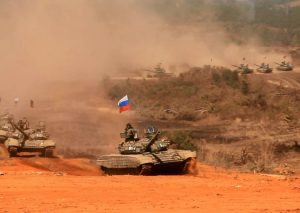Earlier this month, new reports surfaced of a potential new Russian defense facility in Laos. While the notion of such a military facility is by no means new to the relationship, the fresher details that emerged nonetheless once again spotlighted one manifestation of Moscow’s defense presence in the Southeast Asian state.
As I have observed before, Laos and Russia have long had a defense relationship that extends across several realms, including military education, law enforcement cooperation, and military sales. But ties have been on the uptick of late with several key developments over the past couple of years, including the signing of a contract on military and technical cooperation, deals on assistance on helicopter repair and procurement deals, and what was characterized as their first official joint military exercise in Laros 2019.
One aspect of the security ties between the two countries has been talk of establishing defense facilities. As a case in point, as I have noted previously, Russian media reports in 2018 surfaced citing an agreement to open a Russian military facility, allegedly in Vientiane and comprised of technical staff to provide assistance to Laos on defense cooperation. And in December last year, per the Lao defense ministry, the defense minister met with Russia’s ambassador at Moscow’s embassy in Vientiane where both sides discussed ongoing defense work in Xieng Khouang – where the first aforementioned military drills were held – which included the donation of a facility to store tanks, the upgrading of an airport, and the building of a Russia defense office.
Earlier this month, we saw yet another manifestation of what was characterized as a Russia-Laos defense facility in the works. Lao officials reportedly confirmed that Russian troops have been clearing an area with plans to build a new airport and military facility as part of a broader expansion of military aid to the mainland Southeast Asian state.
According to the report by Radio Free Asia, Lao provincial officials, speaking on condition of anonymity, said that a Russian demining team had been working with Lao counterparts to clear an area of around 500 hectares (1,240 acres) of unexploded ordnance (UXO) in Laos’s Xieng Khouang province since December last year to make way for an upgraded airport, with two zones, one for civilian use and the other for Lao and Russian military use. The report also claimed that Moscow is intending to provide substantial military assistance including in training and use of Russian equipment.
The development comes as no surprise given the previous talk of defense facilities and the role that Xieng Khouang has played in previous military collaboration between the two sides. Nonetheless, the development would not be without significance if it eventuates. While the types of cooperation seem in line with what both sides have talked about previously – such as training and advice on military equipment – the establishment of a military facility could provide Russia with a space in Laos where it could gradually build newer forms of defense collaboration that could be concerning to other countries. Beyond Laos itself, it could also potentially provide Russia with a hub within Southeast Asia for some of its defense activities, around which there have been previous rounds of hype with respect to other countries as well.
To be sure, there are still some uncertainties around where exactly all of this could be headed. While some of the work on the new airport may have already begun, one of the provincial officials told RFA that actual construction “will not start anytime soon” because the UXO clearance could take some time. No concrete metrics, including the number of personnel and the exact type of equipment to be stored, have been publicly released, even though the Russia-Laos defense relationship has hardly been known for its transparency. More generally, given that similar Russian initiatives elsewhere in Southeast Asia – be it defense industry facilities in Thailand or equipment sales to the Philippines – have been hyped up but never did quite materialize subsequently, there are reasons to be cautious in reading too much into these early reports.
At the same time, China’s military facilities in Cambodia, which had been raised privately for months before they actually squarely entered the public domain, offer a cautionary tale about prematurely dismissing such facilities until they begin to matter. While Russia as of now may be quite far off China in terms of its security partnerships in Southeast Asia, and Moscow and Beijing in fact compete in some areas, periodic manifestations of Russia’s defense collaboration with individual countries nonetheless offer a reminder that this is still an ongoing development that deserves continued attention.

































